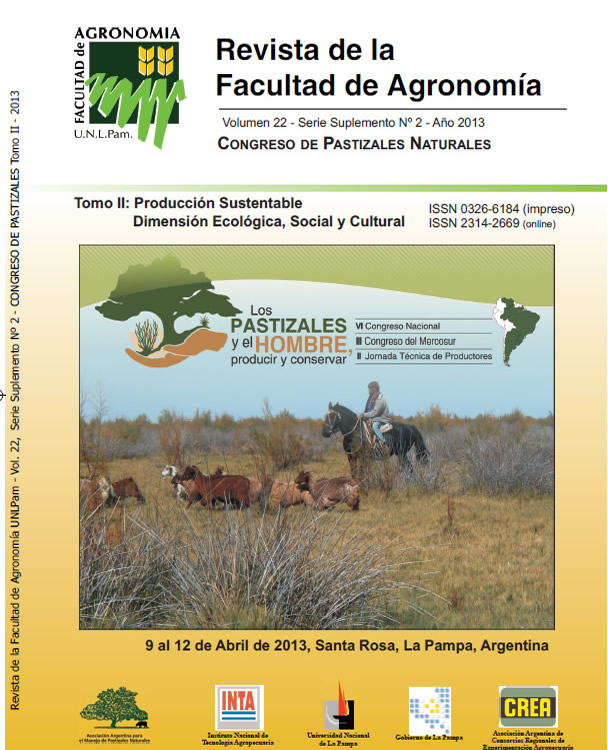Dry matter and protein ruminal degradation and chemical composition in canutillo (Panicum elephantipes) and water hyacinth (Eichhornia crassipes)
Keywords:
rumen, in sacco, protein, Panicum, EichhorniaAbstract
The aim of this work was to identify native and naturalized forage species from the islands of the delta of the Paraná River and to study the fractions that are degraded in rumen. Samples of Eichhornia crassipes (Camalote, CA) and Panicum elephantipes (Canutillo, CN) were taken from the Parana islands. Their chemical composition was determined: Dry Matter (DM %), Ethereal Extract (EE), Ashes (A), Crude Fiber (CF), and Crude Protein (CP; N x 6,25) and the rumen degradation kinetics was determined in sacco for (DR) DM and CP. Data were analyzed with ANOVA Scheffe’s test (P > 0.05) and DR adjusted to the following model: DR%= a + b (1 - e-ct), where is a: soluble fraction, b: slow degradable fraction, c: degradation rate, and a+b: potentially degradable fraction. CA showed 58 % less DM, similar EE and 35.5; 14.1 and 30.9 % more A, CF, and CP respectively, than CN. Degradable fractions in rumen were: DM fraction a: 18 and 21.6 and CP: 17.5 and –4 %, DM fraction b: 50.9 and 41.5 and CP: 42.6 and 80.4 %, degradation DM rate: 0.019 and 0.0384 and CP: 0.033 and 0.048 %/h and a+b fraction of DM: 69 and 63.1 and CP: 60.0 and 76.4 in CA and CN, respectively. CA showed a higher solubility and lower fractions of b, c and a + b of protein than CN. Though CN and CA, appear to be an interesting dietary source for ruminants, showed a lower degradability than known cultivated forage species.
Downloads
References
Acebal M., S. Cechetti, L. Verdura, L. Spiller, F. Calvo & R. Figallo. (2009). Estimación de la digestibilidad en cultivares de alfalfa (Medicago sativa L.) con distintos métodos indirectos. Rev. Arg. Prod. Anim. 29(sup 1): 556-557.
AOAC. 2005. Association of official agricultural chemist. Official Methods of Analysis of AOAC INTERNATIONAL. 18° ED.
Figallo R.M., H.L. Faienza, A. Pidello & A.M. Smacchia 2007. Dry matter ruminal degradation and chemical composition of pasture hays. Biocell. 31(1): 131.
Figallo R.M., H.L Faienza, A. Pidello & A.M. Smacchia 2008a. Dry matter ruminal degradation and chemical composition in pasture. Biocell. 32(3): 24.
Figallo R.M., H.L. Faienza, A. Pidello & A.M Smacchia. 2008b. Dry matter ruminal degradation and chemical composition in residue crop. Biocell. 32(3): 24.
Lahitte H. B. & J.A. Hurrell. 2004. Plantas de la costa. Las plantas nativas y naturalizadas más comunes de la costa del Río Paraná, Isla Martín García y Ribera Platense. Edición 1º. Reimpresión 1. Editorial: L.O.L.A. Buenos Aires.
Meherez A.Z. & E.R. Orskov. 1977. A study of the artificial fibre bag technique for determining the digestibility of feeds in the rumen. J. Agric. Camb. 88: 645.
Orskov E.R. & I. McDonald. 1979. The estimation of protein degradability in the rumen from incubation measurements weighted according to rate of passage. J. Agric. Camb. 92: 944
Downloads
Published
Issue
Section
License
La Editorial de la Universidad Nacional de La Pampa (EdUNLPam) exigirá a los/as autores/as la firma del siguiente documento:
La EdUNLPam lleva a cabo la publicación del artículo: (Título del Artículo) en SEMIÁRIDA Rev.Fac.Agron UNLPam ISSN 2362-4337 (impresa) ISSN 2408-4077 (en línea), del cual el/los abajo firmantes son autores de una o más partes. En el mismo acto, el/los autores entregan exclusivamente a la EdUNLPam todos sus derechos protegidos por las leyes de propiedad intelectual que rigen en la Argentina para reproducir, publicar, editar, fijar, comunicar y transmitir públicamente en cualquier formato o medio impreso o electrónico, inclusive internet, el artículo enviado a publicación e incluirlo en índices o bases de datos nacionales e internacionales. A cambio, la EdUNLPam entrega a los autores la autorización para la publicación o reimpresión con ines académicos y educativos en cualquier libro o medio de divulgación, con la sola obligación de citar el artículo original publicado en la EdUNLPam. Cada autor acuerda en que el material provisto a la EdUNLPam es un trabajo original, que no ha sido impreso o publicado en cualquier otro medio con anterioridad y que no vulnera derechos de terceros. El Primer autor tendrá la posibilidad de leer y corregir el artículo ya editado como “prueba de galera”, pero si el autor no devolviera esas correcciones de la prueba de galera dentro del tiempo especificado, el proceso de producción y publicación podrá proseguir sin la aprobación del autor. El/los autor/es no recibirán compensación monetaria de la EdUNLPam por el uso del material contenido en este artículo y asumen la responsabilidad de las opiniones vertidas en él.






.png)



22.png)



.jpg)




.jpg)
